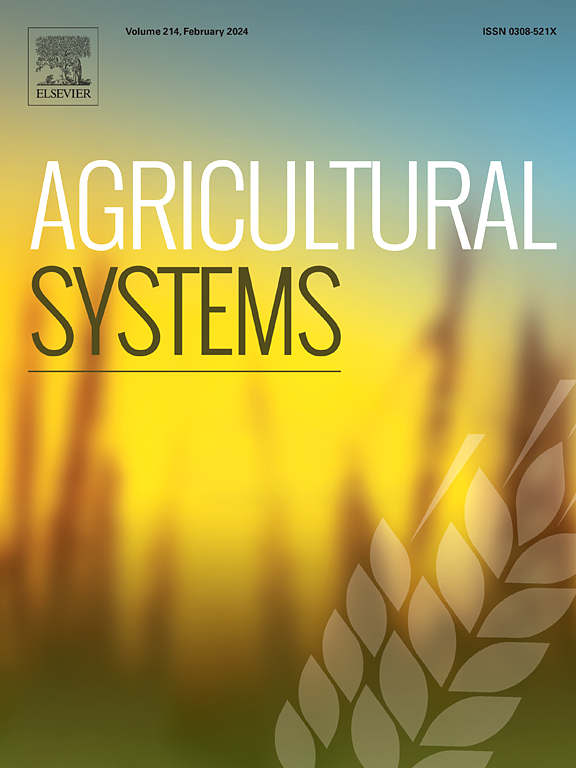基于食物垃圾的水培肥料的系统性审查
IF 6.1
1区 农林科学
Q1 AGRICULTURE, MULTIDISCIPLINARY
引用次数: 0
摘要
内容提要这篇综述文章旨在评估水耕系统中利用从食物垃圾中提取的肥料解决方案(也称为 "基于食物垃圾的水耕肥料"(FWBHF))的现有研究。FWBHF 研究旨在解决人们日益关注的粮食安全问题,同时解决非生产性废物流和水耕肥料的可持续生产问题。据预测,2018 年全球浪费了 9.31 亿吨粮食,占全年粮食总产量的 17%(粮农组织,2021 年)。同时,现有的水培系统依赖于合成肥料,而合成肥料是由不可持续的工艺构成的,例如哈伯-博施系统或磷酸盐岩开采。这些做法严重加剧了温室气体排放,或依赖于对有限储量的破坏性开采,研究人员认为,随着可获取储量的耗尽,这些肥料的价格将会上涨(Liu 等人,2020 年;Cordell 等人,2011 年)。随着城市人口的增加,对从地区进口农产品的需求与废物产生的密度同步增长。因此,探索在城市园艺系统中重新利用城市食物垃圾的方法,可能有助于改善粮食安全、减少浪费,并为消费者提供本地新鲜农产品来源。本综述文章的目的是:i) 利用 PRISMA 协议收集和综合与基于食物垃圾的水培系统相关的现有文献;ii) 确定文献中发现的阻碍基于食物垃圾的水培系统产量结果的主要挑战;iii) 探讨使用常规或非常规方法(包括对现有系统进行化学、物理和生物改造)进行改进的可能性;iv) 为该领域的未来研究提出标准化报告框架:"食物垃圾和水耕法和肥料"、"有机和水耕法和肥料 "以及 "有机和水耕法"。根据标题和摘要的相关性筛选出 308 篇论文。在考虑了质量、重叠性和相关性之后,有 37 篇论文被选入本系统综述。选择文献的依据是其内容是否利用了任何形式的处理方法,将食物垃圾工业产生的废物用于水培系统。这些文献利用了 i) 农场、ii) 工业和 iii) 消费者层面产生的废物,以及发酵、蒸煮或堆肥等一系列新方法。本综述研究了原料成分和加工方法如何在决定基于食物垃圾的水培肥料的功效方面发挥作用。这是因为 "方法 "是研究人员可以影响的主要因素,而原料在很大程度上取决于地区和工业因素。总体而言,没有发现明显的趋势或加工方法特别有效,而 FWBHF 与积极的产量结果之间最密切的关系是其与相应的合成对照方案的相似性。综合现有文献,确定了未来研究的两个主要方向:i) 营养/盐度失衡;ii) 微生物活动。养分缺乏和盐度过高被认为是 FWBHF 研究中的主要限制因素,两者密切相关。缺氮是最常见的养分缺乏症,尽管缺磷也很常见。过高的盐度限制了植物可利用的宏量营养素,在利用 "消费者 "层面产生的食物垃圾的研究中更为常见。培养微生物菌剂有可能通过提高养分矿化度、提高根瘤菌效率或拮抗病原物种来提高植物的总产量。最后,本综述建议采用标准化报告系统。这项研究的起步阶段导致报告标准不规范。建议的报告程序旨在通过明确列出现有文献中已报告的 21 个因素来修正差异,并根据研究领域对论文的相关性进行优先排序。这项研究非常重要,因为它旨在实现城市环境中的三个目标:i) 为食物垃圾提供经济上有益的、本地的和可持续的用途;ii) 通过增加本地粮食生产来改善自身的粮食安全;iii) 发展可持续的城市园艺实践。本文章由计算机程序翻译,如有差异,请以英文原文为准。
A systematic review of food-waste based hydroponic fertilisers
CONTEXT
This review article seeks to evaluate existing research in hydroponic systems which utilise a fertiliser solution derived from food-waste, also known as “Food-waste based hydroponic fertilisers” (FWBHF). FWBHF research is rooted in addressing increasing concerns surrounding food security, addressing both non-productive waste streams and sustainable production of hydroponic fertilisers. In 2018, the world was predicted to have wasted 931 million tonnes of food, 17 % of the total food produced throughout the year (FAO, 2021). Meanwhile, existing hydroponic systems rely on synthetic fertilisers which are constituted from unsustainable processes, such as Haber-Bosch systems or mining for phosphate rocks. These practices contribute heavily to greenhouse gas emissions or rely on destructive exploitation of finite reserves, which researchers believe will increase in price as accessible reserves are exhausted (Liu et al., 2020; Cordell et al., 2011). With increasing population in urban areas, the demand of produce imported from regional areas grows alongside the density of waste generation. Thus, exploring methods to re-utilise urban food-waste in urban horticultural systems may help in improving food security, reducing waste, and providing a local source of fresh produce for consumers.
OBJECTIVES
The objectives of this review article are to : i) Utilise PRISMA protocol to collect and synthesize existing literature related to food-waste based hydroponic systems, ii) Identify major challenges found across literature which inhibit yield outcomes in food-waste based hydroponic systems, iii) Explore potential improvements using conventional or non-conventional methods, including chemical, physical, and biological modifications to existing systems, iv) Suggest a standardized reporting framework for future research in this area.
METHODS
Using the PRISMA protocol, 6840 papers were identified with key words: “Food-waste AND hydroponic AND fertiliser,” “Organic AND hydroponic AND fertiliser,” and “Organic AND Hydroponics.” 308 papers were selected based on the relevance of their title and abstract. After considering quality, overlaps, and relevance, 37 papers were chosen to be part of this systematic review. Literature was chosen based on its contents utilising any form of processing to prepare waste generated from the food-waste industry for use in a hydroponic system. These papers utilised waste generated at i) Farm, ii) Industry, and iii) Consumer, levels as well as a range of novel methods such as fermentation, steaming, or composting. This review studies how both feedstock composition and processing methodologies play a role in determining the efficacy of a food-waste based hydroponic fertiliser.
RESULTS AND DISCUSSION
It was found that while feedstock plays a larger role in the final nutritional composition, categorisation by methodology offers greater clarity for future research. This is attributed to “methodology” being the primary factor researchers can influence, with feedstock being based heavily on regional, industrial factors.. Overall, no clear trends or processing methods were identified as being particularly effective, with the strongest relationship between a FWBHF and positive yield outcomes being its similarity to the corresponding synthetic control solution. Synthesis of existing literature identifies two key avenues for future research: i) nutrient/salinity imbalancesand ii) microbial activity. Nutrient deficiency and excess salinity are identified as the main limiting factors in FWBHF research and are closely related. N deficiency was the most recurring nutrient deficiency, although deficiencies in P were also common. Excessive salinity limits plant available macro-nutrients and was more frequent in research which utilised food-waste generated at “consumer” levels. Cultivating microbial agents may potentially improve overall plant yield by improving mineralisation of nutrients, assisting rhizosphere efficiency, or by antagonising pathogenic species. Finally this review suggests a standardized reporting system. The infancy of this research leads to irregular reporting standards. The suggested reporting procedure seeks to amend discrepancies by clearly establishing a list of 21 factors which have been reported across the available literature and attributes a priority ranking to the relevance of the paper based on its field of study.
SIGNIFICANCE
This review article seeks to develop a synthesis of existing research for a clearer direction of development for food-waste based hydroponic research. This research is important as it aims to accomplish three goals in urban environments: i) Provide economically beneficial, local, and sustainable use for food-waste, ii) Improve their own food security by increasing local food production, and iii) Develop sustainable urban horticulture practices.
求助全文
通过发布文献求助,成功后即可免费获取论文全文。
去求助
来源期刊

Agricultural Systems
农林科学-农业综合
CiteScore
13.30
自引率
7.60%
发文量
174
审稿时长
30 days
期刊介绍:
Agricultural Systems is an international journal that deals with interactions - among the components of agricultural systems, among hierarchical levels of agricultural systems, between agricultural and other land use systems, and between agricultural systems and their natural, social and economic environments.
The scope includes the development and application of systems analysis methodologies in the following areas:
Systems approaches in the sustainable intensification of agriculture; pathways for sustainable intensification; crop-livestock integration; farm-level resource allocation; quantification of benefits and trade-offs at farm to landscape levels; integrative, participatory and dynamic modelling approaches for qualitative and quantitative assessments of agricultural systems and decision making;
The interactions between agricultural and non-agricultural landscapes; the multiple services of agricultural systems; food security and the environment;
Global change and adaptation science; transformational adaptations as driven by changes in climate, policy, values and attitudes influencing the design of farming systems;
Development and application of farming systems design tools and methods for impact, scenario and case study analysis; managing the complexities of dynamic agricultural systems; innovation systems and multi stakeholder arrangements that support or promote change and (or) inform policy decisions.
 求助内容:
求助内容: 应助结果提醒方式:
应助结果提醒方式:


